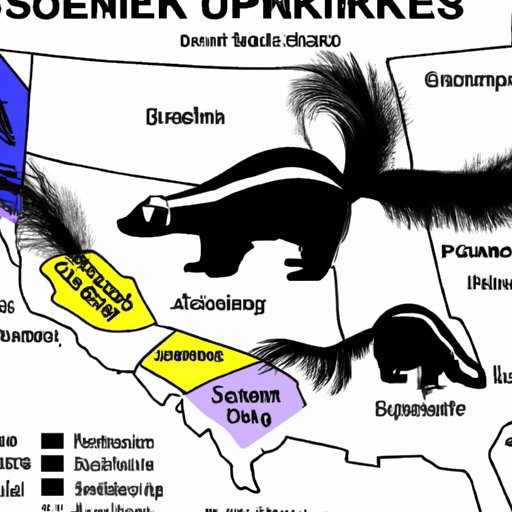Introduction
Skunks are members of the Mustelidae family, which includes weasels, badgers, otters, and ferrets. They are found throughout North and South America, ranging from Canada to Argentina. Skunks live in a variety of habitats, including forests, grasslands, deserts, and even urban areas. As carnivorous mammals, they feed on small animals, insects, carrion, and fruits.
Understanding skunk movement is important for understanding their ecology and behavior. How far do skunks travel? What influences their migration patterns and home ranges? In this article, we explore the various ways that scientists study skunk movement and examine the findings of recent research.
Mapping Skunk Migration Patterns
In order to map skunk migration patterns, scientists first need to track individual skunks. This is done by trapping skunks, attaching tracking devices to them, and then releasing them back into their natural habitat. Tracking devices can provide information on the animals’ movements over time, allowing researchers to observe different types of movement, such as daily activity, seasonal migrations, and long-distance dispersal.
By collecting data on individual skunks, scientists can then analyze it to determine overall migration patterns for a given species or population. For example, a study of striped skunks in Indiana found that the majority of individuals moved less than 10 kilometers from their capture site, although some individuals did disperse up to 30 kilometers away. The study also revealed that males were more likely to move farther than females.

Studying the Habits of Urban Skunks
Urban skunks have adapted to living in close proximity to humans and are often seen scavenging for food in city parks and neighborhoods. To understand how these urban skunks differ from their rural counterparts, scientists have studied their behavior and ecology in detail.
One study compared the diets of urban and rural skunks and found that urban skunks ate more human-related foods, such as pet food, garbage, and birdseed. The study also showed that urban skunks had larger home ranges than rural skunks, suggesting that they needed to search for food over a larger area. Additionally, the study found that urban skunks had fewer social interactions with other skunks than rural skunks, likely because of the increased competition for resources in urban areas.
Exploring Skunk Home Ranges
Home range size is an important factor in determining how far skunks travel, since it indicates the maximum distance an animal may move from its den or home base. Researchers have studied the size and shape of skunk home ranges to better understand skunk movement.
A study of striped skunks in California found that home ranges varied depending on sex and season, with males having larger home ranges than females. The study also found that skunks tended to have larger home ranges in the spring and fall when they were searching for mates and food, respectively. Additionally, the study revealed that home range size was influenced by environmental factors, such as vegetation type, elevation, and the availability of food and shelter.
Examining Skunk Travel Behaviors
In addition to examining home range size, researchers have studied skunk travel behaviors to better understand why and how far skunks travel. A study of spotted skunks in California found that skunks typically traveled short distances, rarely moving more than 500 meters from their den. The study also revealed that skunks travelled mainly at night, likely to avoid predation. Moreover, the study showed that skunks were more likely to travel during periods of low food abundance, suggesting that they may be searching for food.
Investigating Skunk Population Movements
In addition to studying individual skunks, researchers have examined population-level movements to gain insights into how skunks respond to changes in their environment. A study of striped skunks in California found that populations moved in response to changes in climate, with populations shifting to areas with cooler temperatures during the summer months. The study also revealed that human activities, such as road construction, could cause populations to become fragmented, disrupting the normal migratory patterns of skunks.
Analyzing Skunk Movement Over Time
Finally, researchers have looked at how skunk movement has changed over time. A study of striped skunks in California found that the number of skunks moving long distances had declined over the past few decades, likely due to increasing human development. The study also showed that skunks were increasingly being found in urban areas, suggesting that they may be adapting to life in close proximity to humans. Additionally, the study revealed that climate change may be affecting skunk movement, with warming temperatures leading to shifts in migration patterns.
Conclusion
Skunks are adaptable animals that are found across North and South America. Scientists have used tracking devices and analysis of data to study skunk migration patterns, home ranges, travel behaviors, and population movements. Research has shown that skunks can travel up to 30 kilometers from their capture site, with males travelling farther than females. Additionally, urban skunks have been found to have larger home ranges than rural skunks, and climate change may be influencing skunk movement. Further research is needed to better understand how skunks will respond to changing environmental conditions.
(Note: Is this article not meeting your expectations? Do you have knowledge or insights to share? Unlock new opportunities and expand your reach by joining our authors team. Click Registration to join us and share your expertise with our readers.)
